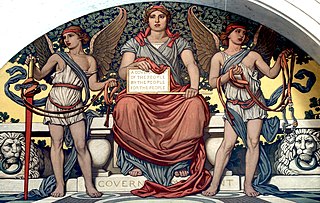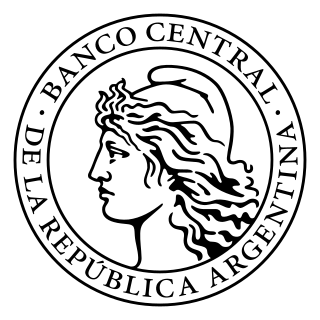Related Research Articles

In economics, inflation is a general increase in the prices of goods and services in an economy. This is usually measured using a consumer price index (CPI). When the general price level rises, each unit of currency buys fewer goods and services; consequently, inflation corresponds to a reduction in the purchasing power of money. The opposite of CPI inflation is deflation, a decrease in the general price level of goods and services. The common measure of inflation is the inflation rate, the annualized percentage change in a general price index. As prices faced by households do not all increase at the same rate, the consumer price index (CPI) is often used for this purpose.

In finance, an exchange rate is the rate at which one currency will be exchanged for another currency. Currencies are most commonly national currencies, but may be sub-national as in the case of Hong Kong or supra-national as in the case of the euro.

Currency substitution is the use of a foreign currency in parallel to or instead of a domestic currency.

The 1997 Asian financial crisis was a period of financial crisis that gripped much of East and Southeast Asia during the late 1990s. The crisis began in Thailand in July 1997 before spreading to several other countries with a ripple effect, raising fears of a worldwide economic meltdown due to financial contagion. However, the recovery in 1998–1999 was rapid, and worries of a meltdown quickly subsided.

Monetary policy is the policy adopted by the monetary authority of a nation to affect monetary and other financial conditions to accomplish broader objectives like high employment and price stability. Further purposes of a monetary policy may be to contribute to economic stability or to maintain predictable exchange rates with other currencies. Today most central banks in developed countries conduct their monetary policy within an inflation targeting framework, whereas the monetary policies of most developing countries' central banks target some kind of a fixed exchange rate system. A third monetary policy strategy, targeting the money supply, was widely followed during the 1980s, but has diminished in popularity since then, though it is still the official strategy in a number of emerging economies.

In public finance, a currency board is a monetary authority which is required to maintain a fixed exchange rate with a foreign currency. This policy objective requires the conventional objectives of a central bank to be subordinated to the exchange rate target. In colonial administration, currency boards were popular because of the advantages of printing appropriate denominations for local conditions, and it also benefited the colony with the seigniorage revenue. However, after World War II many independent countries preferred to have central banks and independent currencies.
A managed float regime, also known as a dirty float, is a type of exchange rate regime where a currency's value is allowed to fluctuate in response to foreign-exchange market mechanisms, but the central bank or monetary authority of the country intervenes occasionally to stabilize or steer the currency's value in a particular direction. This is in contrast to a pure float where the value is entirely determined by market forces, and a fixed exchange rate where the value is pegged to another currency or a basket of currencies.
Foreign exchange reserves are cash and other reserve assets such as gold and silver held by a central bank or other monetary authority that are primarily available to balance payments of the country, influence the foreign exchange rate of its currency, and to maintain confidence in financial markets. Reserves are held in one or more reserve currencies, nowadays mostly the United States dollar and to a lesser extent the euro.

The impossible trinity is a concept in international economics and international political economy which states that it is impossible to have all three of the following at the same time:

An exchange rate regime is a way a monetary authority of a country or currency union manages the currency about other currencies and the foreign exchange market. It is closely related to monetary policy and the two are generally dependent on many of the same factors, such as economic scale and openness, inflation rate, the elasticity of the labor market, financial market development, and capital mobility.

Uruguayan peso has been a name of the Uruguayan currency since Uruguay's settlement by Europeans. The present currency, the peso uruguayo was adopted in 1993 and is subdivided into 100 centésimos, although centésimos are not currently in use.
The Convertibility plan was a plan by the Argentine Currency Board that pegged the Argentine peso to the U.S. dollar between 1991 and 2002 in an attempt to eliminate hyperinflation and stimulate economic growth. While it initially met with considerable success, the board's actions ultimately failed. The peso was only pegged to the dollar until 2002.

The Central Bank of the Argentine Republic is the central bank of Argentina, being an autarchic entity.

José Alfredo Martínez de Hoz was an Argentine lawyer, businessman, and economist. He was the Minister of Economy of Argentina during the country's last military dictatorship (1976—1983), and shaped the economic policy of the dictatorship until its end.
Adolfo César Diz was an Argentine economist who was President of the Central Bank of Argentina from 1976 until 1981.
A fixed exchange rate, often called a pegged exchange rate, is a type of exchange rate regime in which a currency's value is fixed or pegged by a monetary authority against the value of another currency, a basket of other currencies, or another measure of value, such as gold or silver.
In macroeconomics, a flexible exchange-rate system is a monetary system that allows the exchange rate to be determined by supply and demand.

A currency basket is a portfolio of selected currencies with different weightings. A currency basket is commonly used by investors to minimize the risk of currency fluctuations and also governments when setting the market value of a country's currency.
Fear of floating is the hesitancy of a country to follow a floating exchange rate regime, rather than a fixed exchange rate. This is more relevant in emerging economies, especially when they suffered from financial crisis in the last two decades. In foreign exchange markets of the emerging market economies, there is evidence showing that countries who claim they are floating their currency, are actually reluctant to let the nominal exchange rate fluctuate in response to macroeconomic shocks. In the literature, this is first convincingly documented by Calvo and Reinhart with "fear of floating" as the title of one of their papers in 2000. Since then, this widespread phenomenon of reluctance to adjust exchange rates in emerging markets is usually called "fear of floating". Most of the studies on "fear of floating" are closely related to literature on costs and benefits of different exchange rate regimes.
The BONEX Plan was a forced conversion of bank time deposits to Treasury bonds performed by the Argentine government in January 1990.
References
- 1 2 3 Daniel R. Kane (1988). Principles of International Finance. Croom Helm. p. 116. ISBN 9780709931348.
- ↑ "Crawling Peg". Investopedia. Retrieved 2016-01-13.
- ↑ Dat, HoangDuc. "The fifth edition of Maurice D".
{{cite journal}}: Cite journal requires|journal=(help) - ↑ E. Ray Canterbery (2011). The Global Great Recession. World Scientific. ISBN 978-981-4322-77-5.
- ↑ Gang Yi, The People's Bank of China, "Exchange Rate Arrangement: Flexible and Fixed Exchange Rate Debate Revisited, IMF, April 16–17, 2013, pp. 5-6.
- 1 2 Annual Report on Exchange Arrangements and Exchange Restrictions 2014 (PDF). Washington, D.C.: International Monetary Fund. October 2014. p. 6. ISBN 978-1-49830-409-2.
- ↑ Rogers, Tim (May 13, 2014). "Nicaragua seeks to de-dollarize economy". The Nicaragua Dispatch. Archived from the original on February 10, 2017. Retrieved January 13, 2016.
- ↑ "Current Exchange Rate Framework". Bank of Botswana. Archived from the original on 2 December 2023. Retrieved 13 March 2024.
- ↑ U.S. Department of the Treasury (May 2019). "Macroeconomic and Foreign Exchange Policies of Major Trading Partners of the United States: May 2019" (PDF). U.S. Department of the Treasury. p. 36. Archived from the original (PDF) on 2 November 2023. Retrieved 13 March 2024.
- ↑ Barnes, Mark (4 November 2022). "Explained: Implications of the Latest Fed Rate Hike on the Vietnamese Dong". Vietnam Briefing. Archived from the original on 1 April 2023. Retrieved 13 March 2024.
- ↑ "La tablita cambiaria, la medida más recordada de Alfredo Martínez de Hoz". La Nación. 16 March 2013.
- ↑ "Inflación, emisión cero y bandas de no intervención: Las principales frases de Sandleris". La Nación. 26 September 2018.
- ↑ "Argentina to Target 2% Monthly Devaluation of Peso". Bloomberg. 12 December 2023.
- ↑ "Argentina slows peso crawling peg as inflation eases". Reuters. 14 January 2025.
- ↑ Devnath, Arun (8 May 2024). "Bangladesh Introduces Crawling Peg for Taka as Rates Raised". Bloomberg. Archived from the original on 9 May 2024. Retrieved 9 May 2024– via Financial Post.